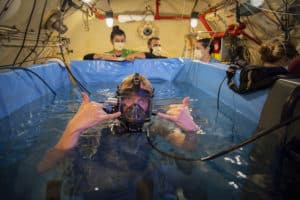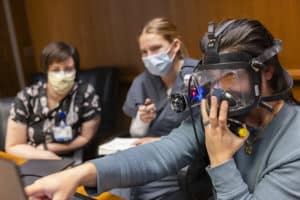Team crafts tool to track neurological function in divers for Office of Naval Research
Published 5.4.23
An IHMC team has wrapped up a three-year project refining an underwater eye-tracking tool to detect the early signs of neurological hazards in divers.
Neurologic decompression sickness, hypoxia, hypercarbia, and Central Nervous System (CNS) O2 toxicity, all are hazards of working in undersea environments. Small eye-movement cameras, known as video-oculographic (VOG) systems, have been used extensively for clinical assessment of eye movements, a quantifiable marker of neurologic function.

An IHMC team testing an underwater eye tracking system at Duke University.
In a project supported by the Office of Naval Research Undersea Medicine Program, the IHMC team modified the Pupil Labs ocular camera system into a waterproof form that fits in the U.S. Navy MK 20 full-face dive mask.
The Pupil Labs system is a mobile, open-source, natural gaze-based system validated across clinical and operational settings. The IHMC team is led by Senior Research Scientist Jeff Phillips and Research Associate Connor Tate.
“Navy divers are exposed to harsh conditions and high levels of stress during submerged critical missions such as search and rescue or explosive ordinance disposal,” Tate said.
Standard laboratory eye-tracking systems provide reliable measures on neurological status, but, Tate noted, “there wasn’t yet a fully waterproofed device for monitoring and evaluation in the submerged environment until our team developed one.”
The IHMC-customized design allows for adjustable use in submerged, hyperbaric settings without compromising the VOG’s ability to effectively capture eye movements.
In early 2023, the IHMC team conducted human testing on the mask they designed at Duke University’s Hyperbaric Medicine facility in Durham, N.C., to see if it would survive under water, and if the interface works.

The IHMC team tested a prototype dive mask fitted with an eye tracking system to help detect early signs of neurological distress in divers.
The system is waterproofed, pressure-tested for implosion and explosion, and tested for electrical leakage — and it performed successfully in all these aspects, Phillips said. The system also was evaluated for data quality, ease of use, comfort, and the ability of the system to detect neurological changes associated with hypercapnia.
For upcoming data collection, Tate said the team will induce hypercarbia in each participant while performing a dive under pressure with the underwater eye tracking system and a system that applies machine learning to the recorded audio of the individual to predict their inhaled CO2 levels.
The combination will allow tracking of participants’ blink rates, fixations, and pupil light reflex, all of which are indicators of fatigue.
“We hope to find a positive correlation between our measures collected by the system and the participants’ CO2 levels and perceived exertion,” Tate said.
Phillips said he was proud of what his team accomplished, especially in the face of the COVID-19 pandemic and its associated supply-chain disruptions.
“Connor and the team displayed immense pluck and resourcefulness despite this being the most difficult time in recent history to accomplish this,” he said.
Latest News
- STEM-Talk: Michael Schmidt on building a space-faring civilization
- Florida Blue award supports health and wellness research and outreach at IHMC
- STEM-Talk: Ken Forbus on AI and his development of the Structure Mapping Engine
- STEM-Talk: Pascal Lee on returning to the Moon — and heading to Mars
- Aging Symposium draws experts to IHMC
- IHMC hosts Fredric G. Levin Lung Care Symposium March 27-28 in Pensacola
- Humanoid robotics and exoskeletons lead latest IHMC newsletter
- Celebrate Robotics Week at IHMC Open House on April 11, 2025
- Registration open for 2025 Summer Robotics Camp

